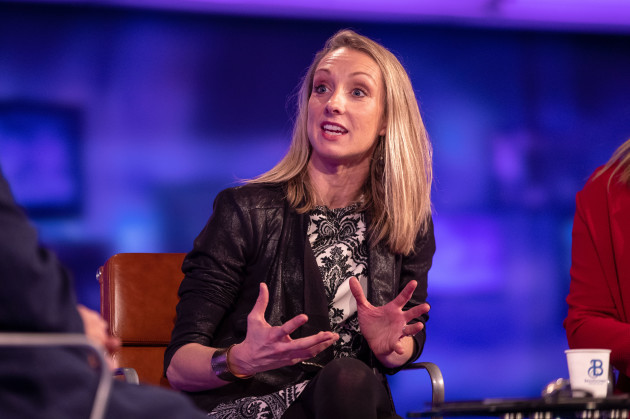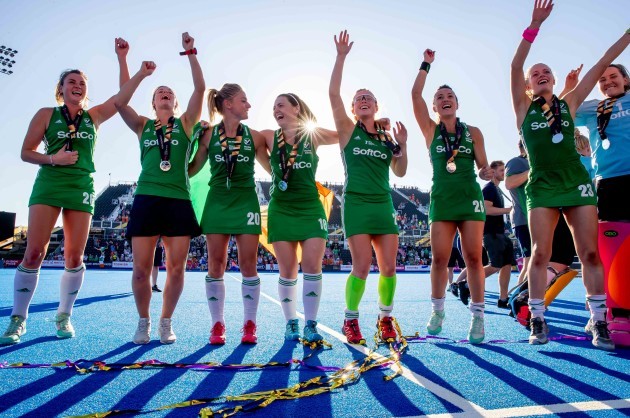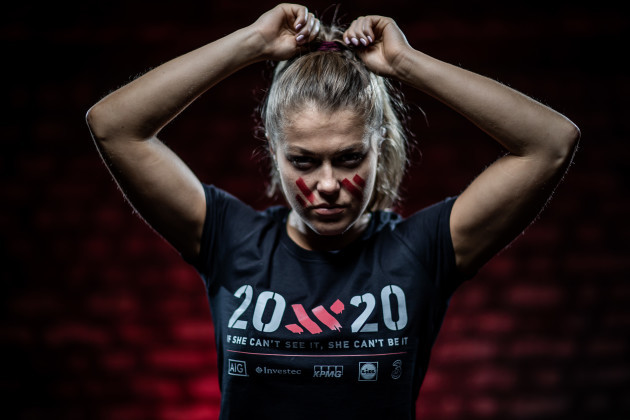IF SHE CAN’T see it, she can’t be it.
Surely, by now, you’ve heard of the 20×20 campaign, which officially launched in mid-October. You’ve seen #20×20, #CantSeeCantBe and #ShowYourStripes over and over as you scroll through social media; you’ve seen the videos, read the articles and saw photo after photo pushing the landmark initiative.
But just incase you’ve been living under a rock, here’s a plain and simple reminder of what the campaign aims to do: increase media coverage, boost attendances and ultimately, grow involvement in female sport by 20% by the end of 2020.
The story behind those 20% targets, the hashtags and the striking red stripes runs much deeper though. Behind the touching experiences and stories told by ambassadors, the powerful videos and thought-provoking messages used to catapult 20×20 into the public eye stands the brains of the operation.
Conversations in an office built on different ideas eventually led to its inception, and everything snowballed from there. The co-founders of Along Came A Spider — a creative agency in Dublin — Sarah Colgan and Heather Thornton, are both mothers of both sexes and had caught themselves, on occasion, treating their sons and daughters differently in terms of sport.
“I had noticed my own auto-pilot reaction with my daughter,” Colgan tells The42 as she sits down to reflect on the campaign thus far, “of basically being much more determined that my son would play sport rather than my daughter.”
Another example she gives is friends in Mayo with three sons and a daughter. With the county’s men’s side in the All-Ireland final in 2017, they were dead cert on going to Croke Park. The week after, the women were also facing Dublin but there was no mad hunt for tickets. They weren’t even going to go until they realised, ‘What are we at, we have three girls, what’s the difference?’ Into the car and off to Dublin they went again, so.
It’s the way it always has been, the done thing. A mindset, the Irish psyche perhaps, with the need for a cultural shift: that’s the real target of the campaign, which is presented by the Federation of Irish Sport.
“With 20×20, what we’re really keen to do is to set some measurable objectives,” Colgan explains, her passion shining through with every last word she utters.
“We had seen that women’s sport is trapped in this cycle of lack of attendances, lack of media coverage and not enough participation at all levels, whether it’s player level, coaching, refereeing or administration,” she says, adding that if they could have a fourth pillar it would be funding and sponsorship.
“To look at breaking the spokes in that wheel meant that we needed to boost participation, we needed to boost attendance and we needed to boost media coverage. By doing that then the funding would also follow.
“Really, the bigger philosophy of 20×20 is to look at our cultural perception of girls and women in sport, and bringing about positive cultural recognition, and celebrating it for being something valuable. That’s really what’s driving everything. If we can get there culturally, then the attendances, participation and media coverage will follow.”
It all kicked off in the public eye on 15 October, the launch day, and chapter one — of five — is all about ‘making us aware of this subliminal bias that we hold towards girls and women in sport’. Colgan stresses that the idea is not to fix anything or make major changes straight away, but to make parents, teachers, sporting bodies and media organisations aware that it is there.
The reaction has been something else There’s been some comparisons drawn to This Girl Can, which is pretty surreal, she says, considering the huge differences money-wise.
“This Girl Can had a budget of £10 million in phase one whereas there’s no advertising spent for this, we can’t book any media, it is all organic. It’s had an incredible reaction organically, not even just with the media but with teams, schools and members of the public contacting us.
“The thing that it’s shown us is the time is 100% now for there being a public appetite for women in sport.
“The fact is though, we are still light years behind men’s sport. It’s brilliant the success stories are there, but women’s sport hasn’t just been visible enough for long enough in order to be able to occupy that same spot in our hearts. It should, it can and it will.”
Visibility. It really is massive. That is, of course, where the tagline if she can’t see it, she can’t be it stems from.
“It’s visibility, not just in terms of column inches or media coverage,” she continues, “but visibility in terms of seeing your neighbour playing, visibility in terms of girls in your class going to training on a Saturday morning, visibility in terms of your mother coaching, visibility in terms of sitting down as a family to actually watch a women’s competition on the TV and going to female games at the weekend.
“If she can’t see it, she can’t be it is not only referring to, ‘I can’t be an elite athlete unless I see female elite athletes around me’. It’s: she can’t be part of what sport gives us culturally if she hasn’t been exposed to it. She, as a sports fan.
“The visibility thing has got to become seen as a normalised part of our culture, of what we do and who we feel we are. For older generations, it’s a bigger leap because women’s sport wasn’t visible. For these younger generations, if it becomes as visible as men’s then we won’t have that hurdle to jump over.
“20-30 years ago women’s sports wasn’t half as prolific as it is now — but it still isn’t half as prolific as it needs to be.”
20×20 is, of course, pushing that more and more with Mary O’Connor and the Federation of Irish Sport ensuring that all sports are also driving the same message.
The campaign is funded by the five official sponsors — an equal split between Lidl, AIG, Three, Investec and KPMG — with Healthy Ireland also offering some support. “They’ve made it entirely possible,” Colgan smiles.
“We don’t have enough money to develop programmes or bigger initiatives or things like that, but what we can do is we can raise public consciousness and rally everybody towards the various targets.”
Those targets, those 20% increases; how exactly does that work? Well, Neilson are their official research partner. The American firm carried out an audit of Irish media before the launch, and those will act as the benchmark statistics. In terms of participation and attendance, National Governing Bodies (NGBs) and Local Sports Partnerships (LSPs) are providing those figures themselves.
Neilson then do an analysis, a before and after if you like, to discover if the targets have been hit at the end of 2020. Colgan says they would love to check in between now and then, but that all depends on budget.
It is tricky, she admits, because each sporting body is set up so differently, each media organisation is starting at a different baseline, things are measured differently everywhere; but that is all being considered.
Each of the NGBs and LSPs can choose a different pillar, or target both participation — covering playing, coaching and officiating numbers — and attendance. The LGFA for example, she explains, have a really wide participation rate and growing that by 20% is too unrealistic, so they’ll go after attendances.
Media then, 20% can be done no matter what, she insists. Although some organisations would consider themselves further ahead of others in their efforts, there’s always other angles to look at. Not just increased coverage, there can be more female commentators, pundits and writers reporting on men’s games as well as women’s games, she says.
“To be honest, I would be really disappointed and surprised if the 20% targets weren’t hit,” Colgan, who spent 13 years as a TV producer before co-founding the agency, adds. “I actually think they should be higher. I think this is a first step, but we need to set higher benchmarks post 2020.”
While the targets are important, it’s about more than those 20%s though.
“The overall goal for this is less about exactly what statistic we get in the different segments, it’s more about if we can create a large and genuine cultural shift in terms of our attitude as Irish society to girls and women’s sport…
“Then we’ve won, the targets are going to be boosted anyway and all of that will follow. It all goes hand-in-hand. If we, as a society, can celebrate, and overcome whatever barriers there are in women’s sport when it comes to our cultural perception, then we’re there anyway.”
She adds, stressing the importance to highlight this: “At no point do we think that 20×20 is coming in here and going to single-handedly take credit for moving the dial for women in sport.
“What 20×20 is there to do is to badge progress across the board for women in sport, to signpost the existing work that’s being done by the national governing bodies in sport, by Sport Ireland, by people who’ve been working in the sporting industry for years and are passionate about this on the agenda as well.
“20×20 is there to collectively be a voice that everyone can stand behind. But in general, it’s important that it’s not a, ‘Women’s sport deserves it…. women’s sport needs it…. we should do it for the girls…..’ That’s bullshit.”
There’s the old sayings that, ‘People aren’t interested’, ‘People don’t want to read about it or watch it’ and, ‘You just can’t make people care.’ Colgan rejects those.
“I think a certain cohort already cares, who have seen it and get it,” she continues.
“They either have played, they have daughters playing, they’ve watched it and they’ve been to games. I almost feel that you’re preaching to the converted there to a certain extent; it’s how do we bring on board those who have had no exposure to it?
“That’s why the exposure and the visibility is key. You and I know, and thanks to say the Hockey World Cup, a lot more people can see that it is as exciting, there is the same thrill, incredible skill.
“It’s not to compare all the time with the men’s game, but it’s seeing it for what it is. How do we start to make those who haven’t been exposed, care?”
That’s the next challenge of the campaign. Phase two is looking at the barriers to entry: a question to the media, to parents, to teachers and to sporting organisations.
“What is it that has stopped us, and what do we all need to do to change that, so that eventually girls and women in sport can occupy the same space in our heart that men’s sport currently does?” she asks.
Those running the campaign can’t be ‘on’ all the time so they’ll target times to peak — spring and autumn 2019 and the same in 2020. There’s 10 films to be released, two of which are out there already; events, news and other exciting things planned to keep the momentum going.
It’s all go.
As she says herself though, “Two years a long time to run with a campaign but it’s a really short time to try to advance girls and women in sport in the way that we feel it should, and could, be.”
The conversation, for the purpose of this piece, pretty much ends there. But it’s still the main focus of our Tuesday morning chat, Colgan’s enthusiasm and passion for the campaign she’s driving is infectious.
The recording device is off by this stage, but she has one more important point to get across and asks to go on the record once again.
“Why? Why is it important? Why does anyone give a shit or why should we care if women’s sport progresses?” she asks, adding that many people’s eyes roll into the back of their heads when it’s even mentioned.
“I think it’s really important to be saying it’s not actually just so girls and women get the benefits of playing sport — that’s a huge part of it — but if we have progressed women’s sport, it’s what it makes us as a society.
“We view ourselves as a very progressive society in Ireland. That’s what suits us. Irish people are so proud of that. By 20×20, whether it’s 50×50 or whatever it ends up being, yes it’s great that it gets all those girls and women playing but I think you’re not asking society to do it for the girls and women, you’re asking society to do it for society’s sake.
“If more of our population are playing, it’s a healthier, happier society everybody’s living in. As a nation of sports fans, if we can nurture more of that then we get two Six Nations to follow, more athletes to tune into, more games to watch.
“We win like that as well, it’s important to bare the, ‘Why should anyone care’ in mind.
“Care for your daughter and care for your girls that are playing, but care on a bigger level for society, as well.”
Absolutely.
- Updated 1.00pm
Subscribe to our new podcast, Heineken Rugby Weekly on The42, here:





